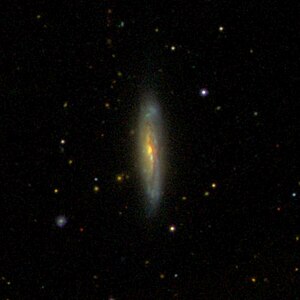NGC 5433
| Galaxy NGC 5433 |
|
|---|---|

|
|
| SDSS recording | |
| AladinLite | |
| Constellation | Hunting dogs |
|
Position equinox : J2000.0 , epoch : J2000.0 |
|
| Right ascension | 14 h 02 m 36.1 s |
| declination | + 32 ° 30 ′ 38 ″ |
| Appearance | |
| Morphological type | Sdm: / HII |
| Brightness (visual) | 13.5 likes |
| Brightness (B-band) | 14.1 mag |
| Angular expansion | 1.6 ′ × 0.4 ′ |
| Position angle | 3 ° |
| Surface brightness | 12.9 mag / arcmin² |
| Physical data | |
| Redshift | 0.014523 +/- 0.000017 |
| Radial velocity | 4354 +/- 5 km / s |
|
Stroke distance v rad / H 0 |
(197 ± 14) · 10 6 ly (60.5 ± 4.2) Mpc |
| history | |
| discovery | Wilhelm Herschel |
| Discovery date | March 20, 1787 |
| Catalog names | |
| NGC 5433 • UGC 8954 • PGC 50012 • CGCG 191-038 • MCG + 06-31-50 • IRAS 14003 + 3245 • KUG 1400 + 327 • 2MASX J14023606 + 3230375 • GC 3753 • H III 653 • h 1737 • | |
NGC 5433 is a 13.5 likes bright spiral radio galaxy from the Hubble type SD in the constellation of hounds on the northern sky . It is an estimated 197 million light years away from the Milky Way and has a disk diameter of about 90,000 ly.
The object was discovered on March 20, 1787 by Wilhelm Herschel with an 18.7-inch reflector telescope, who described it as “vF, pS, E in meridian, 300 power”.
